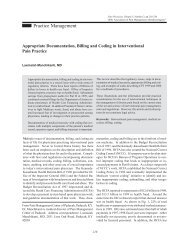ASIPP Practice Guidelines - Pain Physician
ASIPP Practice Guidelines - Pain Physician
ASIPP Practice Guidelines - Pain Physician
Create successful ePaper yourself
Turn your PDF publications into a flip-book with our unique Google optimized e-Paper software.
Manchikanti et al • <strong>ASIPP</strong> <strong>Practice</strong> <strong>Guidelines</strong><br />
44<br />
viously published systematic reviews (45, 66, 67, 421). A<br />
study was considered positive if the therapeutic intervention<br />
was more effective than the reference treatment with<br />
regard to at least one of the outcome measures, which included<br />
pain intensity, overall improvement, functional status,<br />
and return to work. The level of evidence was also a<br />
blend of evidence from AHCPR guidelines (28), as well<br />
as evidence based guidelines from McQuay and Moore<br />
(7). The blended rating system consisted of five levels of<br />
evidence based on the strength as shown in Table 1.<br />
Facet Joint Mediated <strong>Pain</strong><br />
A preponderance of evidence supports the existence of<br />
lumbar facet joint pain (31, 32, 41, 56, 152, 154-157, 177-<br />
183, 374, 376-380, 457-472); however, there are also a<br />
few detractors (348, 351, 473, 474). The diagnosis of the<br />
so called lumbar facet syndrome depends on a clinical presentation<br />
with mechanical low back pain described by the<br />
patient as mainly in the low back with radiation to the buttocks<br />
and upper posterior thigh. Some investigators have<br />
attempted to identify facet syndrome and predictors of<br />
outcome of facet joint injections, which has been rather<br />
futile. The results of most studies failed to show a correlation<br />
between radiologic imaging findings, clinical examination,<br />
and the controlled diagnostic blocks (183). However,<br />
the features of somatic pain may be utilized as a guide<br />
presumably to differentiate somatic pain and radicular pain,<br />
at least initially (Table 4). Similarly, there is also a preponderance<br />
of evidence supporting the existence of cervical<br />
facet joint pain (31, 32, 42, 158-164, 184, 185, 475-<br />
480). Interestingly, the controversy appears to be less in<br />
the cervical spine than in the lumbar spine.<br />
Facet joint mediated pain may be managed by either intraarticular<br />
injections, medical branch blocks, or neurolysis<br />
of medial branches.<br />
Intra-articular Injections: Therapeutic benefit has been<br />
reported with the injection of corticosteroids (458, 460,<br />
462, 463, 470), local anesthetics (457, 474), or normal<br />
saline (347, 457, 468) into the facet joints. The literature<br />
describing the effectiveness of these interventions is abundant,<br />
however, only six randomized clinical trials offer data<br />
on the use of intra-articular injections in the spine (379,<br />
380, 457, 468, 469, 475). Open, uncontrolled clinical studies,<br />
which evaluated the long term relief of back and leg<br />
pain from intra-articular facet joint injections reported variable<br />
relief in 18% to 92% of subjects (458-460, 464-467,<br />
470, 471, 476-480). Five studies of intra-articular corticosteroid<br />
lumbar facet joint injections, and one study in<br />
cervical spine were performed comparing the results to<br />
those of a similar group not receiving intra-articular steroids<br />
(Table 6).<br />
In a prospective, controlled study Carette et al (457) studied<br />
101 patients who received more than 50% relief with a<br />
single intra-articular lidocaine block. Those patients who<br />
responded were randomized into two treatment groups:<br />
intra-articular saline or intra-articular methylprednisolone.<br />
At 1-month follow-up after the injection, 42% of the methylprednisolone<br />
group (20 patients) had significant pain<br />
reduction, whereas 33% of the saline group (16 patients)<br />
achieved significant pain relief. At 6-month follow-up,<br />
however, 46% of the patients in the methylprednisolone<br />
group and 15% of patients in the saline group continued to<br />
experience marked pain relief, with a statistically significant<br />
difference.<br />
Lilius et al (468) studied 109 patients with chronic, unilateral,<br />
nonradicular low back pain who had failed to respond<br />
to conservative treatment, including medication and physical<br />
therapy for a period of 3 to 36 months. A total of 27 of<br />
the 109 patients were postsurgical and had continued pain<br />
despite previous discectomy. They were randomly divided<br />
into three treatment groups: 1) intra-articular lumbar facet<br />
joint injection with cortisone and local anesthetic; 2) intra-articular<br />
injection with saline alone; or 3) pericapsular<br />
injection of cortisone and local anesthetic. Significant pain<br />
relief was reported by patients in all groups for up to three<br />
months. A total of 64% of the patients showed relief one<br />
hour after injection, and 36% of these patients reported<br />
relief from pain over a 3-month period, independent of the<br />
treatment given.<br />
Lynch and Taylor (469) in a controlled, prospective (but<br />
not randomized or blinded) study, reported effectiveness<br />
of intra-articular placement of the corticosteroid without<br />
anesthetic in 50 patients. Extra-articular injection was used<br />
for patients in the control group. Total pain relief was reported<br />
in 9 of 27 patients who received intra-articular corticosteroids<br />
compared with none of the 15 patients who<br />
received extra-articular corticosteroids. Only two patients<br />
in the intra-articular group did not obtain at least partial<br />
benefit, whereas 7 of the 15 control patients had no relief<br />
at all.<br />
Marks et al (380) compared the effects of intra-articular<br />
anesthetic and corticosteroid with medial branch blocks in<br />
a study of 86 patients with chronic low back pain. Patients<br />
were randomized and assigned to either facet joint injections<br />
or medial branch blocks using methylprednisolone<br />
<strong>Pain</strong> <strong>Physician</strong> Vol. 4, No. 1, 2001
















